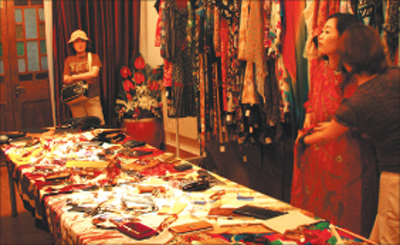 |
Large Medium Small |

When Tian Li, a fashion design teacher, first bought second-hand clothes from Japan 20 years ago, she did it for both aesthetic and financial reasons.
“First of all, they were really cheap — you could get a woolen skirt for a couple of dozen kuai,” she recalls. “Another reason, perhaps the more important one, was that you couldn’t find such ‘trendy’ designs in shops back then.”
In 1980s China, the dominant fashion aesthetic — if there were any — was still heavily influenced by the era of “cultural revolution” (1966-76) that preceded it. The sudden availability of imported clothes offered a break from the era of black and gray, she says, referring to the daring palette of orange, purple and green turquoise that was typical of clothes made in Japan.
In the late ’80s and ’90s, Tian tirelessly amassed more than 100 pieces of such clothing — including dresses, suits and overcoats — from local “night bazaars” in Shenyang, northeastern China’s Liaoning province, where she taught at a fashion school for two decades.
“ I still wear some of these things today,” she says, sounding slightly nostalgic about the days she bent over piles of clothes heaped on the ground, sometimes for hours, searching for pieces that would suit her personal style.
Tian recalls that at its peak, an entire outdoor square in Shenyang was taken over by sellers of second-hand Japanese clothes, similar to what was happening in many other Chinese cities, including Dalian, Qingdao and even Beijing.
All that ended abruptly in the early ’90s, however, when the government decided that the deluge of such clothes, rumored to have been dumped in China by people who would actually have paid to get rid of the “unwanted rubbish”, posed a serious sanitary problem.
What she couldn’t have imagined back then was that the demand for them would stage a sneaky revival, albeit in a different guise.
Japanese clothes with the same bright colors and exaggerated outlines of the ’80s are no longer simply regarded as “second-hand”. In certain, albeit small, parts of the fashion community, they are proudly known as “vintage”.
Jiang Yi, a fashion designer based in Beijing, attributes the phenomenon to what he dubs “the discrepancy in fashion tenses”. “In terms of fashion, what is passé in one time zone may be very happening in another,” he says.
He considers the trend to have nothing to do with one country recycling the “sartorial waste” of another. “To think in that way would be to miss the whole point of it,” he says. “In the 1980s, the majority of linen produced in China, where it was treated as inferior to other materials, such as silk and wool, was exported to Japan.
“These days, to wear pure linen and cotton represents the ultimate style and luxury. In fashion as in love affairs, people sometimes need others to remind them of what they’ve got.”
Jiang does, however, lament China’s lack of recent fashion heritage. “Because of this dramatic fault-line that exists in the country’s contemporary fashion scene, it’s unfair to compare vintage fashion here with that of the United States, Europe or even Japan,” he says. “To look back for our own legacy would be to look past the three decades from the ’50s and ’80s, and directly into the pre-PRC era.”
“But there’s not a lot there that can be borrowed for today.”
All that, according to Jiang, explains why young people rely overly on “borrowed fashion” when they seek to make a statement by reconnecting with the past. Most of them are blissfully unaware of China’s previous and not-so-sweet encounter with these clothes.
And it is in their determination to strike out stylistically that the designer sees a distinct difference between people who shop for second-hand clothes today and those who did 20 years ago. “Between then and now, China has experienced a fashion awakening that has imbued an old trend with new meaning,” he says. “Young people are looking for style, not necessarily bargains.”